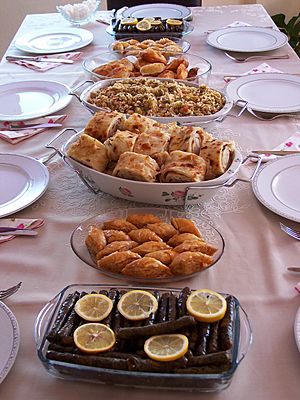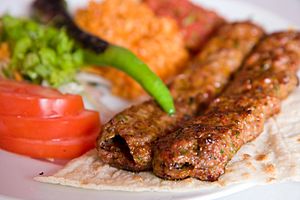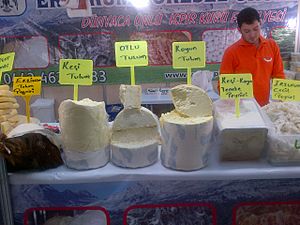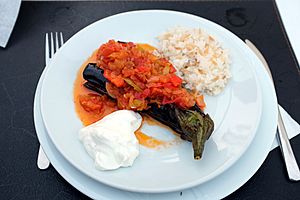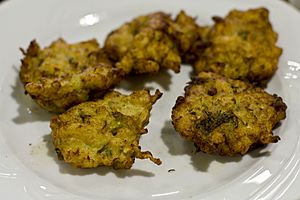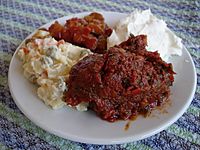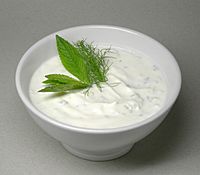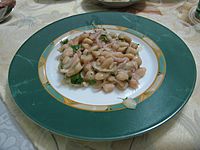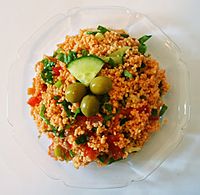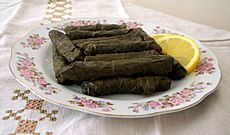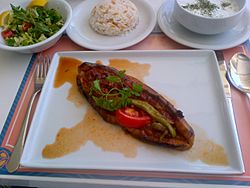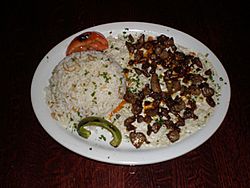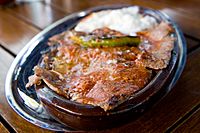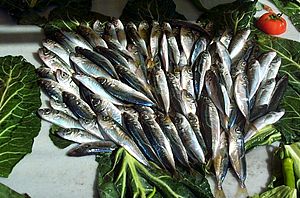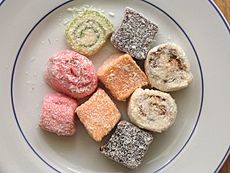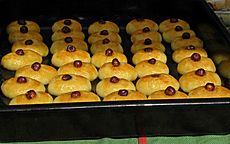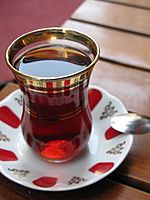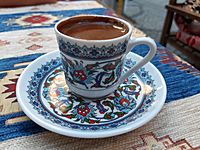Turkish cuisine facts for kids
Quick facts for kids
Turkish Cuisine
|
|
|---|---|
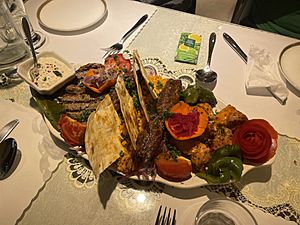 |
|
Turkish cuisine (Türk mutfağı) is the delicious food from Turkey and for Turkish people living in other countries. It's like a big mix of different cooking styles, mostly from the Ottoman Empire. Imagine a blend of foods from the Mediterranean, Balkans, Middle East, and even Central Asia and Eastern Europe. Turkish food has also shared its flavors with these places! The Ottomans were really good at combining different food traditions from their huge empire, creating many special dishes. Some dishes were even invented in the Topkapı Palace kitchen!
Turkish food changes depending on where you are in the country. In big cities like Istanbul, Bursa, and İzmir, the food often uses less spice and prefers rice over bulgur wheat. You'll find many vegetable stews, eggplant dishes, stuffed foods called dolmas, and fish. Near the Black Sea Region, people eat a lot of fish, especially anchovies (hamsi), and enjoy corn dishes. In the southeast, like Gaziantep, the food is famous for its many kinds of kebabs, small appetizer plates called mezes, and sweet pastries like baklava and künefe.
In western Turkey, where many olive trees grow, olive oil is used a lot for cooking. The food in the Aegean Region, Marmara Region, and Mediterranean areas is full of fresh vegetables, herbs, and fish. Central Anatolia has its own famous dishes like keşkek (a hearty stew) and mantı (dumplings), especially from Kayseri. Mantı is similar to dumplings found in Chinese and Korean food, and it's thought to have started in Mongolia a long time ago.
Sometimes, dishes are named after the places they come from, showing how they are made differently. For example, Urfa kebap is less spicy and thicker than Adana kebap. While kebabs are well-known Turkish foods outside Turkey, meals inside Turkey often focus on rice, vegetables, and bread.
Eating Habits
Breakfast Time
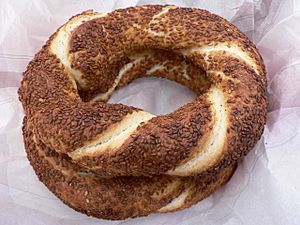
A traditional Turkish breakfast is very rich and has many different foods. A typical breakfast usually includes cheese, butter, olives, eggs, tomatoes, cucumbers, jam, honey, and a creamy dairy product called kaymak. You might also find spicy Turkish sausage (sucuk), cured beef (pastırma), pastries like börek and simit (a circular bread with sesame seeds), and fried dough. Soups are also sometimes eaten for breakfast.
A special breakfast dish is menemen, made with tomatoes, green peppers, onion, olive oil, and eggs. Another special dish is kuymak, a cheesy cornmeal dish. Çılbır, also known as Turkish eggs, is made with poached eggs and yogurt. And of course, Turkish tea is always served at breakfast. The Turkish word for breakfast, kahvaltı, actually means "before coffee."
Home-Cooked Meals
Turkish people really love to eat homemade food. Even though many young people now eat out more, most Turks still prefer meals cooked at home. A typical meal often starts with soup, especially in winter. Then comes a main dish, which could be vegetables cooked with olive oil or meat, or a stew made with meat or beans. This is often served with Turkish pilav (rice), pasta, or bulgur pilav, along with a salad or cacık (a cold yogurt dish with garlic, salt, and cucumber). In summer, many people enjoy cold vegetable dishes cooked with olive oil instead of soup.
Eating Out
Even though fast food is becoming popular in Turkey, people still mostly enjoy the many traditional Turkish dishes. Some Turkish foods, like köfte (meatballs), döner, kokoreç (grilled lamb intestines), and börek, are often served as fast food. Eating out has always been common in big cities. You can find many esnaf lokantası (restaurants for shopkeepers), which serve traditional Turkish home-cooked meals at good prices.
Summer Foods
In the hot Turkish summer, meals are often lighter. People enjoy fried vegetables like eggplant, peppers, or potatoes, served with yogurt or tomato sauce. Menemen and çılbır are also popular summer dishes made with eggs. Sheep cheese, cucumbers, tomatoes, watermelons, and melons make for a refreshing summer meal. If you like helva for dessert, there's a special "summer helva" that is lighter and less sweet.
Main Ingredients
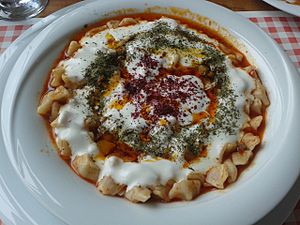
Some common ingredients in Turkish food are lamb, chicken, beef, fish, rice, eggplants, green peppers, onions, garlic, lentils, beans, zucchinis, chickpeas, and tomatoes. Nuts like pistachios, chestnuts, almonds, hazelnuts, and walnuts are very important. They are used a lot in desserts or eaten on their own. Spices are also a big part of Turkish cooking.
Olives are often found at breakfast and on meze plates. Beyaz peynir (white cheese) and yoğurt are used in many dishes, including börek, mantı, kebab, and cacık.
Oils and Fats
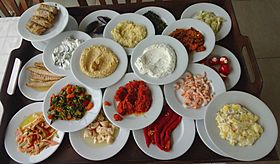
Butter, margarine, olive oil, sunflower oil, canola oil, and corn oil are widely used for cooking. Oils from sesame, hazelnut, peanut, and walnut are also used. Sometimes, kuyruk yağı (sheep tail fat) is used in kebabs and meat dishes.
Fruits in Cooking
Turkey has many different kinds of fruits that are fresh and affordable. In the old Ottoman kitchens, fruit often came with meat dishes. Plums, apricots, pomegranates, pears, apples, grapes, and figs, along with many citrus fruits, are often used in Turkish cooking, either fresh or dried. For example, komposto (fruit compote) or hoşaf (sweet fruit drink) are common side dishes with meat or pilav. Dolma and Pilav often have currants or raisins. Some old Ottoman recipes even cooked vine leaves stuffed with meat and rice with sour plums! Turkish desserts usually don't have fresh fruit, but they might use dried fruits.
Eggplant (patlıcan) is a very special vegetable in Turkish cuisine.
Meats in Meals
In some parts of Turkey, meat used to be eaten mostly at weddings or during special holidays like Kurban Bayramı (Eid ul-Adha), often as etli pilav (rice with meat). But now, with modern farming, meat is more often part of daily meals. Veal, which wasn't eaten much before, is now popular.
Meat is often mixed with vegetables, like kıymalı fasulye (beans with ground meat) or kıymalı ıspanak (spinach with ground meat), which is sometimes served with yoğurt.
In towns near the coast, cheap fish like sardines or anchovies are easy to find, along with other seasonal fish. Chicken and eggs are also commonly eaten. Young lambs, once the most popular meat, are now eaten less often. Cooking a whole lamb on a spit (kuzu çevirme), which used to be a big event, is rarely seen today.
Popular Dishes
Dairy Delights
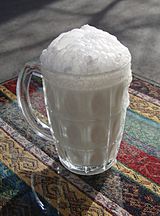
Yoğurt is super important in Turkish food. The English word "yogurt" actually comes from the Turkish word yoğurt! You can eat yogurt with almost any meat dish, vegetable dish, meze, and especially with mantı (dumplings). In villages, people often eat yogurt with pilav or bread. Süzme yoğurt, or "strained yogurt," is a thicker, creamier kind. One of the most common Turkish drinks, ayran, is made from yogurt. Yogurt is also used in cakes, some soups, and pastries.
Turkish Cheeses
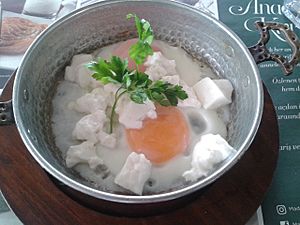
Turkey makes many kinds of cheese, mostly from sheep's milk. These cheeses are usually not aged for a long time and have less fat. Many cheeses are special to certain regions.
- Beyaz peynir is a salty white cheese, like feta but not as strong. It's eaten plain (for breakfast), in salads, and in cooked foods like menemen and börek.
- Kaşar is another very common cheese, a medium-fat sheep's cheese. Less aged kaşar, called fresh kaşar, is also popular.
- Tulum is a sheep's cheese molded in an animal skin bag. There are different kinds of tulum cheese depending on the region.
- Otlu peynir is "herbed cheese" made in many areas, especially in East Anatolia. It uses different herbs depending on the region.
Soups
A Turkish meal often begins with a light soup (çorba). Soups are usually named after their main ingredient. Some common types are mercimek (lentil) çorbası, yogurt soup, and tarhana çorbası (made from dried fermented mixture of yogurt and wheat). Some special soups, like İşkembe soup (tripe soup), are usually not eaten every day. Before Turkish breakfast became popular, soup was a common morning meal for some people.
Here are some common Turkish soups:
- Yayla çorbası (yogurt soup)
- Ezogelin çorbası (a spicy lentil and bulgur soup)
- Mercimek çorbası (lentil soup)
- Tarhana çorbası
- Sulu köfte (meatball soup)
Breads
- Bazlama (a flatbread)
- Gözleme (a thin, savory flatbread)
- Mısır ekmeği (corn bread)
- Lavaş (a thin flatbread)
- Poğaça (soft rolls)
- Pide (a broad, round, flat bread)
- Simit (a ring-shaped bread covered with sesame seeds, often eaten for breakfast)
- Yufka (a very thin, round flatbread)
Pastries
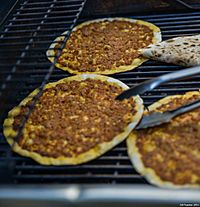
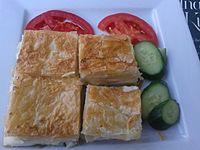
Turkish cuisine has many tasty pastries, both savory and sweet. Dishes made with layers of dough are a big part of traditional Turkish food. This style of layered dough comes from the early Turkish people who were nomads in Central Asia.
Börek is the general name for savory pastries made with yufka (a thin dough). Su Böreği (meaning 'water pastry'), made with boiled yufka layers, cheese, and parsley, is very popular. Çiğ börek is fried and filled with minced meat. Kol böreği is another well-known börek named after its shape.
Poğaça is a name for salty pastries made with dough. Çörek is another name for both sweet and salty pastries.
Gözleme is a common food in rural areas. It's made from lavash bread or yufka dough folded around fillings like spinach, cheese, minced meat, or potatoes, then cooked on a large griddle.
Katmer is another traditional rolled-out dough. It can be salty or sweet. Katmer with pistachio and kaymak is a sweet dish and a popular breakfast item in Gaziantep.
Lahmacun is a thin flatbread topped with spiced minced meat, tomato, pepper, onion, or garlic.
Pide is one of the most common traditional Turkish foods cooked in a stone oven. It can be topped with minced meat, kaşar cheese, spinach, white cheese, meat pieces, or eggs.
Açma is a soft, bagel-like bread found all over Turkey. It's similar to simit in shape and is often eaten for breakfast or as a snack.
Pilav and Pasta Dishes
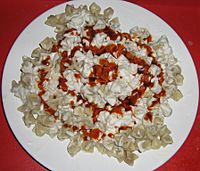
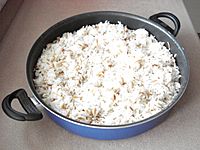
- Pilav: Plain rice pilav is often served with any meal. It's made by cooking rice with butter and water or broth. There are many kinds of pilav, like tomato pilav, pilav with meat, or pilav with chickpeas. Bulgur pilavı is made from wheat and often mixed with tomato, green pepper, and minced meat.
- Mantı: These are Turkish dumplings made of small triangles of dough filled with minced meat, onion, and parsley. They are usually served hot with garlic yogurt, melted butter or olive oil, and spices like oregano and red pepper. Mantı is often eaten as a main dish.
- Erişte: This is homemade Turkish pasta. It can be cooked with vegetables or used in soups and rice dishes.
- Keşkek: A hearty stew made from meat and wheat or barley.
- Kuskus: The Turkish version of couscous, which can be served with any meat dish or stew.
Vegetarian Options
Vegetable Dishes
Vegetable dishes can be the main course in a Turkish meal. Many different vegetables are used, such as spinach, leek, cauliflower, artichoke, cabbage, celery, eggplant, green and red bell peppers, string bean, and jerusalem artichoke. A typical vegetable dish starts with chopped onions and carrots cooked in olive oil, then tomatoes or tomato paste are added. Finally, the vegetables and hot water are added, often with a spoon of rice and lemon juice. These dishes are usually served with their cooking liquid and are called sulu yemek (meaning "a dish with juice"). Minced meat can be added, but vegetable dishes cooked with olive oil (zeytinyağlılar) are often served cold and don't have meat. Spinach, leek, string bean, and artichoke with olive oil are very popular in Turkey.
Dolma is the name for stuffed vegetables. Dolma cooked with olive oil does not contain meat. Many vegetables are stuffed, most commonly green peppers (biber dolması), eggplants, tomatoes, or zucchini (kabak dolması), and vine leaves (yaprak dolması). The fillings can include parts of the vegetable itself, rice with spices, or minced meat.
Mercimek köfte, despite its name, does not contain meat. It's made mainly from red lentils with spring onion and tomato paste.
Imam bayildi is a version of karnıyarık (stuffed eggplant) without minced meat. It can also be served as a meze.
Fried eggplant and pepper is a common summer dish, served with yogurt or tomato sauce and garlic.
Mücver is made with grated squash or potatoes, egg, onion, dill, cheese, and flour. It can be fried or baked.
Pilav can be a side or main dish. Dishes made with kuru fasulye (white beans), nohut (chickpeas), mercimek (lentils), and börülce (black-eyed peas), cooked with onion, vegetables, minced meat, tomato paste, and rice, are always popular because they are affordable and healthy.
Turşu is a pickle made with salty water, often with garlic. It's a common appetizer and can be made with many different vegetables. In coastal towns, the liquid from turşu is sometimes drunk.
Egg Dishes
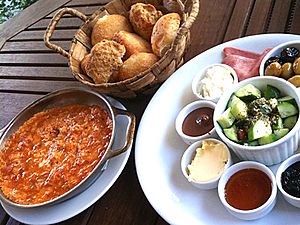
- Menemen is scrambled eggs cooked with tomato, green pepper, and sometimes onion and garlic.
- Çılbır is poached eggs served with yogurt and oil.
- Ispanaklı yumurta is eggs cooked with spinach and onion.
- Kaygana is like a mix between a pancake and an omelet, sometimes served with cheese, honey, or nuts.
Meze and Salads
Meze is a selection of small dishes served as appetizers, sometimes with drinks. Some mezes can even be a main meal.
Besides olives and different kinds of cheese, popular Turkish mezes include:
- Acılı ezme – a hot and spicy mashed tomato dish with onion and herbs.
- Acuka – a spread made from red pepper paste, walnuts, tomato paste, and spices.
- Arnavut ciğeri (meaning "Albanian liver") – fried liver cubes served with onion and hot pepper.
- Patlıcan salatası – eggplant salad.
- Piyaz – white bean or potato salad with onion and vinegar.
- Cacık – cucumber with yogurt, dried mint, and olive oil.
- Çiğ köfte – raw meat patties (or a vegetarian version with tomato paste and fine bulgur).
- Çoban salatası – a mixed salad of tomato, cucumber, onion, green peppers, and parsley.
- Dolma – stuffed vegetables like vine leaves, peppers, or mussels filled with rice or meat.
- Humus – a spread made from sesame tahini, chickpeas, garlic, olive oil, and lemon juice.
- Kısır – a very popular dish made with fine bulgur, tomato paste, parsley, onion, and spices.
Dolma and Sarma
Dolma means 'stuffed thing' and Sarma means 'wrapped thing' in Turkish. Both are very special in Turkish cooking. They can be eaten as an appetizer or a main dish, and can be made with vegetables or meat. If they have meat, they are usually served hot with yogurt and spices. If they are vegetarian, they are made with olive oil, rice or bulgur, and sometimes nuts and raisins, and served cold.
Zeytinyağlı yaprak sarması (stuffed leaves with olive oil) is sarma made with vine leaves stuffed with a rice and spice mix, cooked with olive oil. This kind of dolma is vegetarian and served cold. In old Ottoman cooking, dried fruits like blackcurrants, raisins, figs, or cherries, along with cinnamon and allspice, were added to sweeten zeytinyağlı dolma. Vine leaves can also be filled with meat and rice (etli yaprak sarma), which is often served hot with yogurt.
Many different kinds of dolma are made today. Common ones include courgette (kabak), aubergine (patlıcan), tomato (domates), pumpkin (balkabağı), pepper (biber), cabbage (lahana), and mussel (midye) dolma.
Meat Dishes
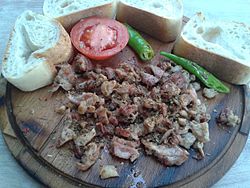

- Döner kebap: Made with chicken or lean veal, this is a popular Turkish fast food.
- Tantuni: Meat cut into very small pieces, served with lavash bread. It's a specialty from Mersin.
- Kuzu güveç: Lamb cooked in an earthenware pot.
- Kavurma: This means frying or roasting in Turkish. It's usually roasted lamb or other fried meat dishes. Çoban kavurma is a type made with diced lamb, tomatoes, onions, mushrooms, peppers, and herbs.
- Hünkârbeğendi: The name means "the sovereign liked it." This dish has grilled eggplant puree with kaşar cheese, topped with cubed lamb meat.
- Türlü: A stew of vegetables and meat cooked in a güveç (casserole).
- Karnıyarık: Fried eggplants filled with minced meat, onion, garlic, and tomato paste, then baked.
- Köfte: Meatballs are another popular meat dish. The name often includes a town's name, like İnegöl köftesi or İzmir köfte, showing how it's made or what ingredients are used in that region.
- Sucuk: A spicy raw sausage (made with beef and garlic) often eaten for breakfast. It's also used in toasts and sandwiches.
- Pastırma: Another famous cured beef. Both pastırma and sucuk can be added to kuru fasulye (dry beans) for extra flavor. They are also served as meze or with scrambled eggs for breakfast.
- Kokoreç: Grilled sheep intestines with spices, a traditional and affordable fast food.
- Liver: Fried liver is common. Arnavut ciğeri (Albanian liver), served with onion and sumac, is often eaten as a meze. Edirne ciğeri is another famous liver dish.
Kebabs
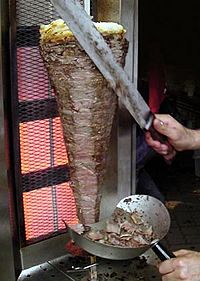
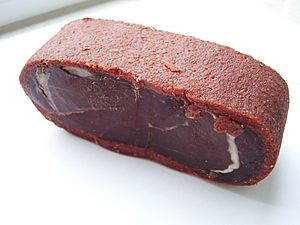
Kebab refers to many different meat dishes in Turkish cuisine. It includes not only grilled or skewered meats but also stews and casseroles.
- Adana kebap – minced meat mixed with chili on a flat skewer, popular all over Turkey.
- Alinazik kebab – ground meat kebab with garlic, yogurt, and eggplant.
- Beyti kebab – seasoned ground lamb or beef, grilled on a skewer, often wrapped in lavash and topped with tomato sauce and yogurt.
- Cağ kebab – lamb cubes roasted on a horizontal rotating spit, a specialty from Erzurum.
- Ciğer kebabı – liver kebab, usually eaten with sliced onions, salad, and bread.
- Çöp şiş – small skewer kebab, made with pounded boneless meat, tomatoes, and garlic on wooden skewers.
- Döner kebab – meat cooked on a vertical rotating spit.
- İskender kebap – döner kebap served with yogurt, tomato sauce, and butter, from Bursa.
- Kuzu şiş – shish kebab made with marinated lamb meat.
- Köfte kebap – minced lamb meatballs with herbs, grilled on a stick.
- Patlıcan kebabı – kebab meat served with eggplant, hot pide bread, and yogurt sauce.
- Shish kebab – made with fish, lamb, or chicken meat on thin skewers, grilled.
- Şiş tavuk – yogurt-marinated chicken grilled on a stick.
- Tandır kebabı – lamb pieces baked slowly in a special oven called a tandır.
- Urfa kebabı – similar to Adana kebap but less spicy.
Fish Dishes
Turkey is surrounded by seas with many kinds of fish. Fish are grilled, fried, or cooked slowly by steaming (buğulama). Buğulama is fish cooked with lemon and parsley, covered so it steams. Pilâki is fish cooked with vegetables in the oven. In the Black Sea region, fish are often fried with thick corn flour. Fish can also be eaten cold, smoked, dried, canned, salted, or pickled.
Popular sea fish in Turkey include:
- anchovy (hamsi)
- sardine (sardalya)
- bonito (palamut)
- gilt-head bream (çupra)
- red mullet (barbun)
- sea bass (levrek)
- bluefish (lüfer)
Desserts
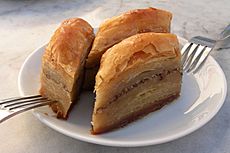
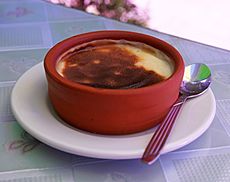
One of the most famous Turkish desserts is baklava. It's made with many thin layers of dough and filled with pistachios or walnuts. Turkish cuisine has other desserts similar to baklava, like şöbiyet and sarı burma.
Kadayıf is another common Turkish dessert made with shredded dough. There are different types, like tel (wire) or Burma (wring) kadayıf, both with walnuts or pistachios.
Künefe and ekmek kadayıfı are rich desserts soaked in syrup and butter, often served hot with kaymak (clotted cream). Künefe has a layer of melted cheese inside.
Among milk-based desserts, popular ones are muhallebi (milk pudding), sütlaç (rice pudding), keşkül (almond pudding), kazandibi (a burnt milk pudding), and tavuk göğsü (a chewy milk pudding with finely shredded chicken breast).
Helva is another type of dessert. There's un helvası (flour helva), irmik helvası (semolina helva with pine nuts), and tahin helvası (made from crushed sesame seeds).
Other popular desserts include Revani (semolina cake), şekerpare (syrup-soaked cookies), tulumba (fried dough soaked in syrup), and lokma (fried dough balls with syrup).
Güllaç is a dessert often eaten during Ramadan. It has very thin dough layers soaked in milk and rose water, served with pomegranate seeds and walnuts.
Aşure is a sweet soup with boiled beans, wheat, and dried fruits. It's said to have been first cooked on Noah's Ark with seven different ingredients. People all over Anatolia still make aşure, especially during the month of Muharrem.
Some traditional Turkish desserts are made with fruit: ayva tatlısı (quince), incir tatlısı (fig), and kabak tatlısı (pumpkin). Fruits are cooked with sugar, cloves, and cinnamon, then served chilled with walnuts or pistachios and kaymak.
Homemade cookies are called kurabiye. Common types are acıbadem kurabiyesi (almond cookies) and un kurabiyesi (flour cookies).
Tahin-pekmez is a traditional mix of sesame paste (tahin) and grape syrup (pekmez), often eaten in rural areas.
Lokum is a famous sweet candy with many different kinds.
Cezerye (a carrot and nut candy) and pestil (fruit leather) are other common sweets.
Marzipan (almond paste) is also a common sweet in Turkey.
Kaymak (clotted cream) is often served with desserts to balance their sweetness.
Turkish tea or Turkish coffee is usually served after dinner or with desserts.
Street Food
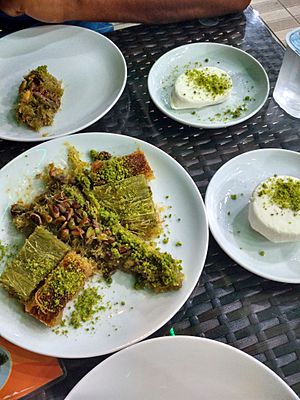
When you walk around in Turkey, you'll find many tasty street foods:
- Dondurma (Turkish gum ice cream)
- Iced almonds (buzlu badem)
- Fried mussels, stuffed mussels (midye)
- Gözleme (thin flatbread stuffed with various fillings)
- Kokoreç (grilled lamb intestines)
- Fish bread (balık ekmek) – grilled fish served in bread
- Kumpir (a baked potato with cheese and many other toppings)
- Lokma (fried dough balls with syrup)
- Roasted corn (közde mısır)
- Roasted chestnuts (kestane)
- Simit (sesame bread rings)
Drinks
Non-Alcoholic Drinks
Turkish people drink black tea (çay) all day long. Tea is made in two teapots in Turkey: strong tea from the top pot is mixed with hot water from the bottom. Turkish coffee (kahve) is usually served after meals or with dessert.
Ayran (yogurt drink) is the most common cold drink. It's a mix of yogurt and water, similar to lassi, and can be served with salt. It goes well with almost all Turkish dishes, except fish.
Şalgam suyu (mild or spicy fermented black carrot juice) is another important non-alcoholic drink, often paired with kebabs or rakı.
Boza is a traditional winter drink, made from millet (a type of grain). It's served cold with cinnamon.
Sahlep is another winter favorite, served hot with cinnamon. It's made from the roots of wild orchids and is also used in Turkish ice cream.
Limonata (lemonade) is very popular. It's traditionally served with baklava and other sweets. Sometimes, strawberry flavor is added, called çilekli limonata.
Sherbet (Turkish şerbet) is a sweet syrup made from many ingredients like fruits, flowers, or herbs. It's drunk mixed with cold water.
In traditional Turkish cooking, hoşaf (a sweet fruit drink) often goes with meat dishes and pilav.
Similar Cuisines
- Albanian cuisine
- Armenian cuisine
- Azerbaijani cuisine
- Balkan cuisine
- Central Asian cuisine
- Cypriot cuisine
- Greek cuisine
- Iranian cuisine
- Levantine cuisine
- Mediterranean cuisine
- Middle Eastern cuisine
- Ottoman cuisine
|
See also
 In Spanish: Gastronomía de Turquía para niños
In Spanish: Gastronomía de Turquía para niños


